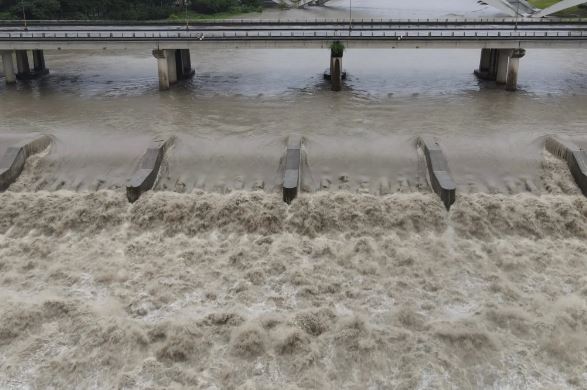Typhoon Gaemi, a powerful tropical cyclone, was weakening as it approached mainland China on Thursday, following its devastating impact on Taiwan. The storm’s fierce winds and heavy rains led to widespread flooding, disrupted transportation, and forced the suspension of hundreds of flights in Taiwan.
The typhoon made landfall in Taiwan on Wednesday night with wind speeds comparable to a Category 3 hurricane in the Atlantic Ocean, according to the Joint Typhoon Warning Center, a U.S. Navy forecasting organization.
As of Thursday, Gaemi was traversing the Taiwan Strait and was predicted to make landfall in the southeastern Chinese province of Fujian later in the day, with wind speeds equivalent to a Category 1 hurricane. The Chinese mainland, including regions already grappling with heavy rains and floods, braced for the storm’s impact.
Taiwan, an island nation with a population of about 23 million, lies approximately 100 miles from the Chinese coast. The proximity and trajectory of the typhoon have prompted extensive preparations and emergency responses on both sides of the Taiwan Strait.
In Fujian, the provincial capital of Fuzhou implemented precautionary measures, including banning group gatherings, closing schools and tourist sites, and ordering nonessential businesses to shut down. Coastal provinces adjacent to Fujian were also on high alert, evacuating tourists from vulnerable areas and directing ships to seek safe harbor to avoid the storm’s wrath.
The China Meteorological Administration warned that Typhoon Gaemi would bring substantial rainfall to various parts of the country, including the capital city, Beijing, as it moved inland over the next five days. Southern China, already experiencing weeks of heavy rainfall and severe flooding, was particularly concerned about the additional precipitation and potential exacerbation of flood conditions.
In Taiwan, the storm’s impact was profound, with some local weather stations reporting nearly four feet of rainfall by Thursday morning. The Central Weather Administration of Taiwan estimated that total rainfall from Typhoon Gaemi could reach almost six feet, exacerbating flooding and landslide risks across the island. The torrential downpours inundated roads, disrupted public transportation, and caused widespread property damage.
The storm also wreaked havoc on Taiwan’s power infrastructure. More than 600,000 electricity customers experienced outages since the typhoon’s landfall, according to Taipower, the state-owned utility company. As of Thursday afternoon, approximately 15 percent of those affected were still without power, highlighting the scale of the damage and the challenges faced by repair crews working to restore service.
In response to the typhoon, Taiwan’s government and emergency services mobilized extensive resources to manage the crisis. Evacuation orders were issued in high-risk areas, and temporary shelters were established to accommodate displaced residents. The military and other rescue organizations were on standby to assist in relief efforts and provide aid to those affected by the storm.
The impact of Typhoon Gaemi extends beyond immediate physical damage, with concerns about the long-term effects on agriculture, infrastructure, and local economies. The storm has also highlighted the challenges of emergency preparedness and response in regions prone to severe weather events, particularly in the context of climate change, which is increasing the frequency and intensity of such disasters.
As Typhoon Gaemi continues its journey towards mainland China, authorities are urging residents in affected areas to stay informed about weather updates and adhere to safety protocols. The storm’s progression will be closely monitored, with further warnings and advisories expected as the situation evolves.
The aftermath of Typhoon Gaemi serves as a stark reminder of the power of natural disasters and the importance of coordinated efforts in disaster preparedness, response, and recovery. Both Taiwan and China will need to assess and address the storm’s impacts in the days and weeks ahead, as communities begin the process of rebuilding and recovery.

